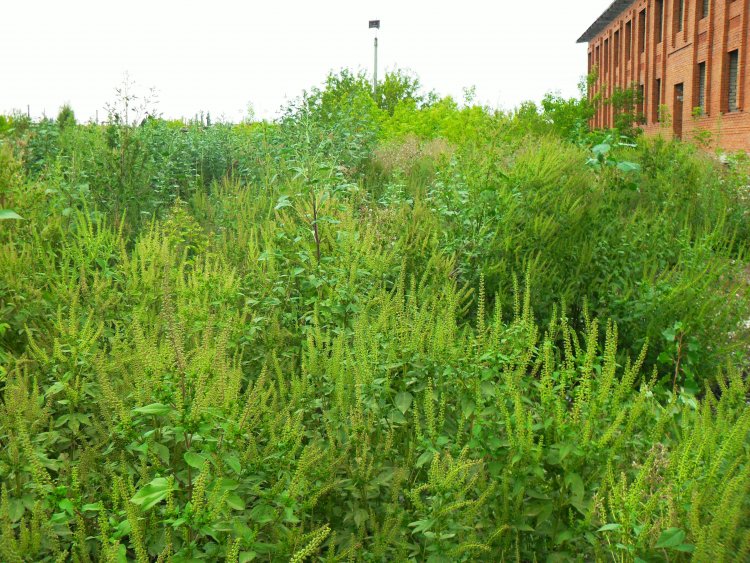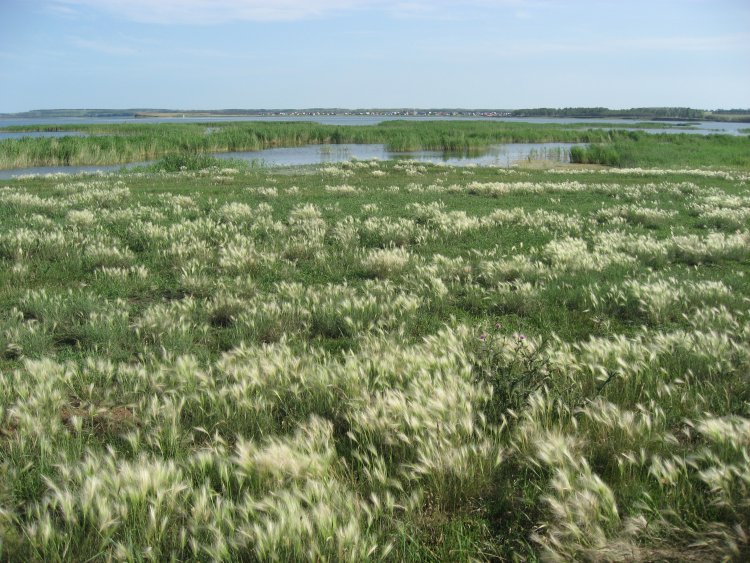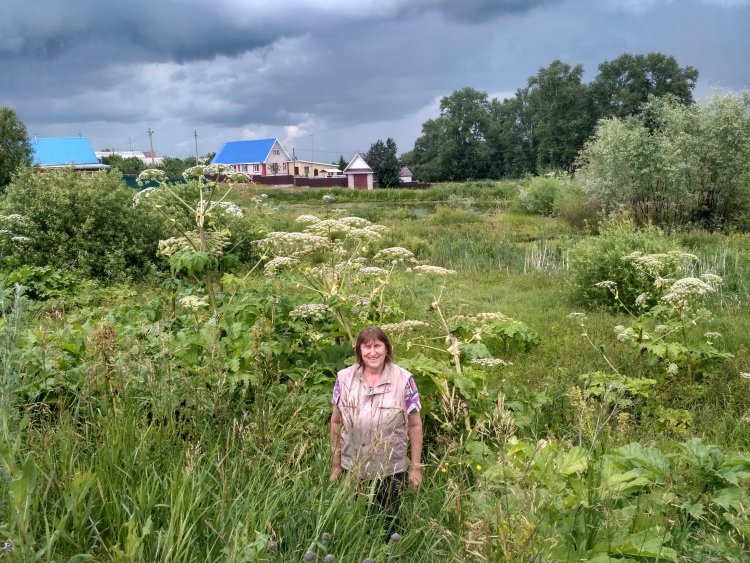Ufa biologists have been working for many years to study the consequences of the spread and impact as well as harm assessment of invasive (aggressive) species on the biodiversity of the Southern Ural Mountains
The intrusion of invasive (alien or non-native) species into natural communities from other countries or regions is now observed not only in the European part of Russia but also in the Urals and Siberia. Invasions can not only pose a threat to human health (cause severe allergic reactions and diseases, burns) but also make changes in the agricultural production system (for example, the seizure of fertile soil, floodplain areas for grazing, competition with perennial grasses in meadow communities, a decrease in the yield of field crops).
In the Southern Urals and the Republic of Bashkortostan, the settlement and spread of invasive species exacerbate the difficult ecological situation already caused by air pollution with industrial by-products. Alien species have not only adapted to the local climatic conditions but also firmly established themselves, displacing local plant species.
The team of the the Laboratory of Wild Flora and Introduction of Herbaceous Plants of the South Ural Botanical Garden-Institute of Ufa Federal Research Centre RAS (Ufa) has been engaged in research of new invasive species on the territory of the Southern Urals and the Republic of Bashkortostan for many years. Scientists study in detail the localization, communities with the participation of an invasive species, morphological features, reproductive ability, and determine the level of invasive potential. As a result, experts analyze the causes and environmental threats from the introduction of alien plant species to identify the degree of their participation in ecosystems and to control the spread of harmful invasive species. In addition, Ural biologists monitor the foci of invasion and select methods to constrain the most aggressive invasive plant species.
Larisa Mikhailovna Abramova – Professor, Doctor of Biological Sciences, chief researcher of the Laboratory of Wild Flora and Introduction of Herbaceous Plants of the South Ural Botanical Garden-Institute of Ufa Federal Research Centre RAS (Ufa) – spoke about the regional specifics of invasive flora and the prerequisites for the intensification of expansion of invasions in the plant communities of Bashkiria and the Southern Urals, as well as about the next year publication of the Black Book, which will contain a list of alien species potentially harmful to the ecosystems of the studied region.
“The problem of invasion of alien species is one of the most urgent environmental problems of our time. Invasions of alien organisms (plants and animals) are now recognized as one of the leading factors in the transformation of natural ecosystems, and invasive alien species are among the most important threats to natural biodiversity around the world. The introduction of invasive species leads to a reduction in biological diversity and the displacement of native plant and animal species. In addition, some invasive species pose a direct danger to human health – it is enough to mention, for example, Sosnovsky’s hogweed or common ragweed. Many alien species cause significant damage to the economy – they become malicious weeds or pests of crops (the most famous example is the Colorado potato beetle).” – Larisa Abramova pointed out the reasons for studying the invasion of alien plants and the consequences of their settlement in secondary habitats.
What is the key vector of your scientific research: are you interested in invasion as a phenomenon of the spread of alien species, or do you consider them as an ecological threat to native species?
“We are interested in all aspects of invasive processes occurring in the Southern Urals: from the first appearance of a new species in the region, the speed and ways of its spread, to its introduction into natural plant communities. But the main vector of research is the impact of invasive species on biological diversity, the assessment of harm to natural ecosystems, as well as the search for ways to curb the further settlement of invasive neophytes,” – clarified the researcher.
How do the plant communities of Bashkortostan react to the introduction of alien plants? What is the competitive and environmental impact of invasive plants, which leads to a decrease in the diversity of native communities (the displacement of some species), up to the extinction of individual species?
“As a rule, invasive plant species have high competitive and adaptive capabilities, which allows them to adapt to a variety of habitat conditions and grow in different types of communities. A number of species, in addition, transform the soil and ecological conditions for themselves (such species are called transformers) – for example, the boxelder creates dense shading, there is almost no natural herbaceous vegetation under its canopy. Some invasive species affect competitors by biochemical methods – they secrete substances that suppress the shoots of other plants. Most alien species are perfectly adapted to live in anthropogenically disturbed ecosystems, consume resources that are not used by local species and overtake them in terms of growth rate, do not have enemies and pests in our conditions. All these qualities allow them to capture habitats and become dominant in them, displacing other plant species. Aboriginal communities can resist the invasion of “invaders” only if they are not disturbed, which is rare in modern conditions, or their living conditions are unsuitable for invasions – for example, in the highlands, swamps, or tundra,” – Larisa Abramova explained.
Today, there is a wide expansion of invasive species in Bashkortostan. Have new habitats of invasive species been identified? Which species has the most negative impact on the plant communities of Bashkiria? Which of them is represented by the largest number of localities?
“We have been researching invasive processes in the Republic of Bashkortostan and the Southern Urals as a whole for the past 25 years. During this time, about 100 invasive and potentially invasive plant species that make up the “blacklist” of our flora have been identified. The first category of plants with harmful impact includes 11 species, among which there are two species of ragweed, Sosnovsky’s hogweed, boxelder, giant sumpweed, foxtail barley, and others. These species are represented by a large number of localities and have the most negative impact on the ecosystems of the region. We have identified hundreds of foci of invasion of these most harmful plants. The main localities are within the settlements of the region, but many species also settle in the floodplains of rivers, along roads, in meadows, and even in the steppes, such as foxtail barley, which is found even in specially protected natural areas: for example, on the shore of Lake Aslikul in the Asly-Kul Nature Park. Ragweed and sumpweed have allergenic pollen, and hogweed gives severe burns, it causes significant damage to people’s health,” – Larisa Abramova said.
Giant ragweed in Salavat.
Foxtail barley on the shore of Lake Aslikul (Asly-Kul Nature Park).
Pictured: Professor Larisa Abramova in the thicket of Sosnovsky’s hogweed. Yanaulsky district, Murzino village.
Today, Sosnovsky’s hogweed has spread to many territories of our country, including the Southern Urals. How did this invasive species adapt to local living conditions, to local insects and microorganisms?
“Sosnovsky’s hogweed is an example of an irresponsible introduction into the culture of a plant that is potentially invasive and dangerous for people. It came out of the fields to meadows, forests, and settlements, and the fault in its wide expansion is entirely on the mankind. Our territory was lucky to some extent – here it was not widely cultivated and until recently we did not experience such problems as the Northwest of Russia, Moscow, and several other central regions. But in the Middle Urals, this plant was cultivated, and it is found everywhere, for example, in the Perm and Sverdlovsk regions, from where it gradually moves along the roads to the northern regions of Bashkortostan. To date, only 22 foci of invasion of Sosnovsky’s hogweed have been identified, most of which are quite small. The hogweed has successfully adapted to the conditions in the forest and forest-steppe zone of the Urals and can after a very short time settle in all the northern and central regions of the republic, as well as in the mountainous zone. There are no examples of its presence in the steppe zone yet, but even there it can find refuge in the forested floodplains of rivers and streams. The hogweed is highly resistant to all measures for its destruction and produces a large number of seeds because it attracts local insects with an abundance of nectar, which complicates the task of controlling the foci of its invasion. Therefore, we refer this species to the first category of harmful impact. Nevertheless, today it is still possible to put a barrier to the spread of this harmful weed in the Southern Urals, but it is necessary to act quickly until the point of no return has passed. It is necessary to add hogweed to the list of quarantine plants and throw all our efforts at eradicating it in the places where it appeared,” – Larisa Abramova expressed her opinion.
The thicket of giant sumpweed near the farm in Verkhniy Muynak village of Zianchurinsky district.
How are the populations of invasive species monitored and their numbers controlled in the territory of Bashkortostan? What are the ways to deter aggressive species? What experiments are you conducting to control the number of some invasive species by agrotechnical and chemical methods?
“The monitoring of populations of quarantine species, such as, for example, ragweed and Russian knapweed, is carried out by the Federal Service for Veterinary and Phytosanitary Surveillance (Rosselkhoznadzor). But unfortunately, there are very few such species in the quarantine list, and, for example, hogweed and giant sumpweed are not included. We are constantly monitoring the appearance and spread of new harmful alien species through our small laboratory, but this, of course, is not enough for such a large territory as the Southern Urals. In many countries of Europe and America, entire institutes have been established that deal with biological invasions and control of invasive species foci. We must also move in this direction because this problem will not disappear by itself, and the introduction of new alien organisms with the development of ties between states, transport routes, and active population movement will only increase. Methods of controlling the number of foci of invasion do exist, they include both more environmentally friendly agrotechnical and biological methods of control, and chemical methods, without which, unfortunately, in the case of large foci of invasion, it is impossible to manage. We also conducted successful experiments on the control of foci of such species as ragweed and giant sumpweed. The problem is, who will apply these methods on a full scale, in large areas? To shift this task onto the shoulders of the plot owners, as experience shows, means to let the situation float freely, and the example of hogweed shows what this leads to. We need a special service like the Ministry of Emergency Situations, which will “extinguish the fire” in those regions where there are pockets of harmful alien species…” – said Larisa Abramova, Chief Researcher of the South Ural Botanical Garden-Institute of Ufa Federal Research Centre RAS.
Currently, Ural scientists are preparing to publish “The Black Book of the Flora of the Republic of Bashkortostan” under the guidance of Professor Larisa Abramova, using a grant from the Russian Foundation for Basic Research. The co-authors are Yaroslav Mikhailovich Golovanov, Candidate of Biological Sciences, Senior Researcher of the South Ural Botanical Garden-Institute of Ufa Federal Research Centre RAS, and Albert Akramovich Muldashev, a well-known Ural florist, Candidate of Biological Sciences, Leading Researcher of the Ufa Institute of Biology of the Ufa Federal Research Centre RAS.
The book contains data on 93 alien plant species that are not indigenous to the nature of Bashkortostan and can be considered invasive or potentially invasive species of different invasive statuses. Information about them includes an indication of the first find and all the localities of the species’ growth that are reliably known at the moment, author’s photos, distribution maps, information about biology, ecology, origin, time and method of introduction, degree of naturalization, communities with the participation of species, the toxicity or harmfulness of the species, and possible methods of control.
Larisa Abramova notes that “the “Black Book of the Flora of the Republic of Bashkortostan” was conceived a long time ago and we have been collecting information for it for the past 10–15 years; these works were carried out, including with the financial support of two grants from the Russian Foundation for Basic Research. If we talk about the tasks of such publications, the “Black Book” is the antipode of the Red Book, and if red book plants need to be preserved, the plants from the blacklist should be disposed of. Black books contribute to informing the general population and environmental organizations about the current spread and negative consequences of the settlement of alien species, reducing environmental damage from biological invasions and preserving biological diversity.”
The Black Book is intended for botanists, ecologists, university teachers, and students, as well as for specialists of state bodies of phytosanitary supervision, environmental organizations, agriculture and forestry, environmental public associations, and, of course, will be useful to a wide range of readers. The book is scheduled to be published in March 2022 by the Moscow KMK Publishing House.
Larisa Abramova is convinced that the work of Ural scientists collected in this monograph “will serve the cause of cleaning ecosystems from “floral pollution” by alien invasive species.”
Thus, the identification of foci of particularly aggressive invasive species, their inclusion in the list of quarantine plants, the development of measures for destruction, monitoring of invasions of alien organisms should become deterrents to undesirable “intruders” (introductions) in different regions of the country.
*All images are provided by Larisa Abramova

























